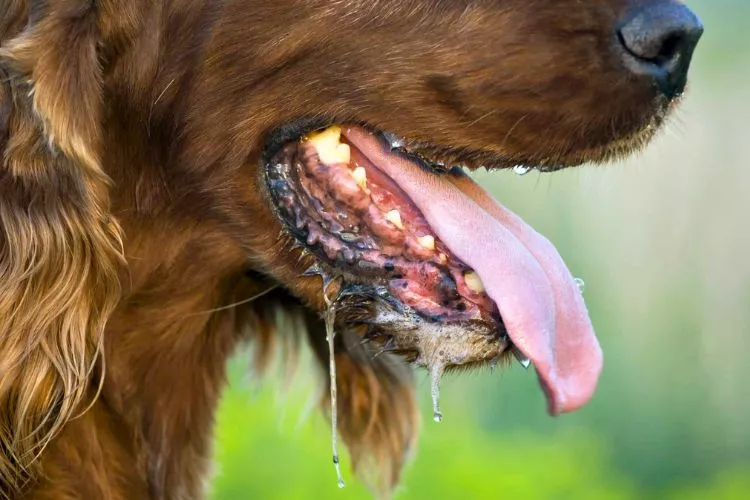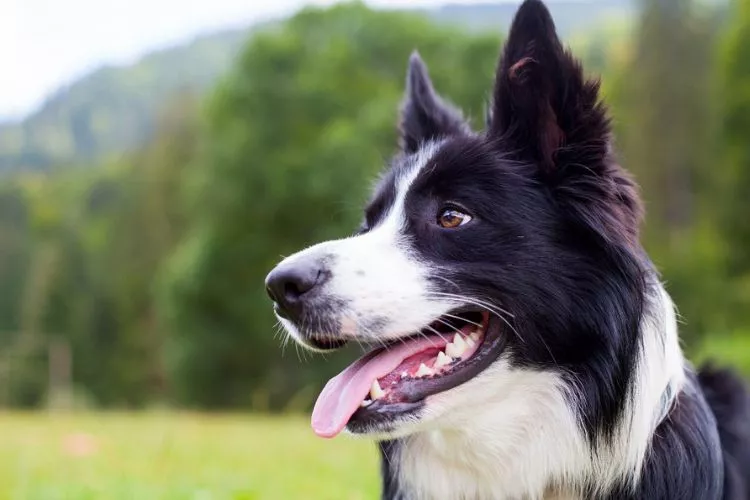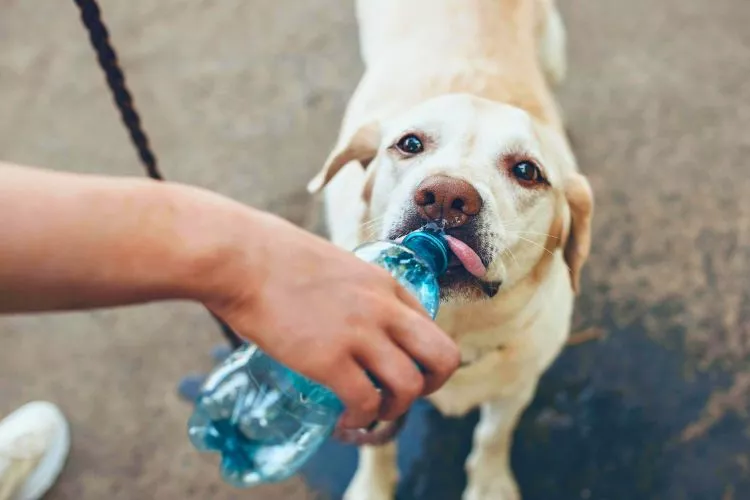As a dog owner, we’ve all noticed our canine companion panting and wondered, “Is my dog normal, why is my dog panting or should I be concerned?”
It’s an intrinsic part of their behavior; still, it leaves many of us puzzled.
Panting is more than just their way of cooling down on a hot day or after a vigorous play session. It can be a barometer of their overall wellbeing, hinting at potential health issues that could go unnoticed.
This article delves into the rationale behind your dog’s panting, interprets the hidden signs and elaborates on preventative measures.

We aim to aid you in making the most informed decisions for your fur friend’s health and happiness.
🐾 Why Is My Dog Panting?
Dogs pant for various reasons, including natural physiology and underlying health issues. Below are several factors that contribute to your dog’s panting:
- Thermoregulation: Unlike humans, dogs don’t have sweat glands throughout their bodies. Panting serves as their primary means of releasing excess heat and cooling down. As a dog breathes rapidly, moisture from their lungs and tongue evaporates, cooling them off.
- Excitement or Anxiety: Emotions often trigger panting in dogs, whether due to excitement from playing fetch or anxiety from a thunderstorm. Rapid breathing can be a coping mechanism to release tension and signal their owners that they’re feeling overwhelmed.
- Physical Activity: Dogs pant to catch their breath after a workout, just like humans do. They require additional oxygen to recover and maintain their energy level.
- Pain or Discomfort: Panting can indicate acute pain or discomfort. Monitor your dog for additional symptoms or behavioral changes indicating injury or illness, and consult a veterinarian if necessary.
- Obesity: Overweight dogs tend to pant more than their healthier counterparts. Excess body fat can make breathing or cooling down difficult, placing additional stress on the respiratory system. It’s crucial to maintain a healthy weight through proper diet and exercise.
- Medical Conditions: Chronic panting may point to underlying health issues, such as heatstroke, heart problems, respiratory disorders, anemia, or Cushing’s disease. If your dog’s panting seems excessive or unusual, it’s essential to consult a veterinarian for a proper diagnosis and treatment plan.
Observing your dog’s panting patterns is crucial to recognize deviations from their normal behavior. By paying close attention, you can identify changes that could signal potential health risks and seek the appropriate care for your beloved canine companion.
🐾 When should I worry about dog panting?
While panting is common in dogs due to heat, excitement or exercise, you should be concerned about your dog panting under certain circumstances.
Immediate veterinary care is necessary when panting is due to heatstroke, characterized by heavy panting, dehydration, and observable discomfort. Persistent and excessive panting may indicate health problems like heart disease, respiratory disorders, or other systemic issues.

This is especially so when it deviates from what is usually observed in your dog. Breeds with brachycephalic airway syndrome are also predisposed to louder, potentially worrisome panting.
Therefore, if you notice any unusual changes in your dog’s panting pattern or additional signs of distress or discomfort accompanying it, it is best to consult a veterinarian.
Early detection and intervention can significantly impact your dog’s wellbeing.
🐾 How long is too long for a dog to pant?
Timing on panting can vary widely, depending on several factors, including the dog’s health, physical activity, and environmental conditions.
A healthy dog, for instance, might pant for around 10 minutes after vigorous exercise.
However, prolonged panting, particularly if it’s heavy or abnormal, could indicate an issue. It’s difficult to specify an exact duration indicating “too long,” as it greatly depends on the individual dog and circumstances.
Other signs, such as discomfort or behavioral changes, can provide further clues that something may be wrong.

Suppose you notice excessive panting that’s out of the ordinary for your dog or lasting longer than what you consider usual. In that case, it’s always best to consult a vet for professional advice.
Please remember that any hesitations or concerns about your dog’s health should always be directed to a licensed veterinarian. They can provide qualified advice tailored specifically to your pet’s needs.
🐾 What is considered excessive panting?
Excessive panting is a term used to describe a level of panting in dogs that is much heavier, more rapid, or more prolonged than their typical panting under similar conditions.
To determine if your dog is experiencing excessive panting, consider the following factors:
- Context: This could be considered excessive if your dog is panting heavily without an apparent reason, such as high temperature or physical exertion.
- Comparison to Normal Panting: Observe your dog frequently to know its normal panting patterns when exercising, hot, or excited. It could be excessive if the panting becomes significantly heavier, faster, deeper, or lengthier than usual.
- Duration: If your dog’s panting doesn’t subside within a reasonable amount of time after a triggering event (e.g., a bout of physical activity) or continues without an identifiable cause, it might be excessive.
- Breathing Rate: Generally, a relaxed dog breathes between 10 and 30 breaths per minute. It could indicate excessive panting if their panting rate doubles or triples from their typical count in similar situations.
- Panting During Rest: When a dog is panting heavily at rest or during sleep, this could indicate excessive panting.
By closely monitoring your dog’s breathing, you can better understand their normal panting patterns and more easily identify when they’re experiencing excessive panting.
Whenever you’re concerned about the severity or frequency of your dog’s panting, it’s always best to consult a veterinarian for professional advice tailored to your pet’s needs.
🐾 What are the first signs of heartworms in dogs?
The first signs of heartworms in dogs usually manifest as subtle changes as this disease progresses slowly. The earliest symptoms can include:
- General fatigue: Dogs may seem unusually tired after only mild exercise.
- Coughing may be sporadic at first but will progressively become more persistent.
- Loss of appetite and weight loss: Heartworm-infected dogs may eat less and thus lose weight.
- Unexplained weight loss without changes in appetite.
- Difficulty breathing and shortness of breath: This symptom typically arises as the disease progresses.
- Protruding ribs and swollen belly: As heartworms cause fluid accumulation, dogs’ bodies may change shape.
Remember, early detection is crucial in managing heartworm disease. Therefore, regular screening through a blood test is recommended. If your dog shows any of these symptoms, seek veterinary advice promptly.
🐾 What are the signs of respiratory distress in a dog?
Respiratory distress or dyspnea in a dog can manifest in several ways, including the following:
- Increased breathing rate: A typical resting dog takes 10 to 35 breaths per minute. More than this may indicate distress.
- Labored breathing: Dogs might use their abdominal muscles more noticeably when breathing.
- Noisy breathing: Dogs experiencing respiratory distress might start wheezing, snoring, or making unusual noises while breathing.
- Changes in tongue or gum color: Blue or pale gum/tongue color can indicate oxygen deprivation.
- Restlessness or anxiety: Dogs may seem unusually restless or display signs of panic or extreme anxiety.
These symptoms can be due to various causes, including allergic reactions, pneumonia, heart disease, or a foreign object lodged in the throat. If you notice these signs, getting your dog to the vet immediately is crucial.
🐾 How do you help a dog who is panting a lot?
Excessive panting in dogs can be due to various reasons, but several strategies exist to help your pet. One of the most common causes is heat; the simplest method to mitigate this is to help them cool off.
This could involve moving your dog to a cooler location, allowing them to cool off in a stream, or using water from a hose or shower.
Panting can also be associated with discomfort or anxiety. A comforting presence can alleviate anxiety-related panting. Simply staying next to your dog can provide a sense of security.

However, excessive panting could be a symptom of more complex health problems, including heartworm, pain, Cushing’s syndrome, or respiratory issues.
Therefore, if your dog is panting excessively without apparent cause or if it persists, it is strongly recommended to consult a veterinarian. Regular checkups and early diagnosis can help manage these conditions.
Remember, understanding your pet’s normal behaviour is vital, as dogs also pant after exercise or when they’re excited. Equating such panting to a health issue may not always be correct.
Monitor other symptoms and behaviors associated with the panting to better identify the cause. Never hesitate to consult a professional when in doubt.
🐾 Frequently Asked Questions (FAQ)
Your dog could be panting and shaking due to several reasons, primarily stress, fear, or a medical condition. Stress or fear-driven panting and shaking are common during thunderstorms, fireworks, or unfamiliar environments. Medical issues that could induce these symptoms range from a simple fever to serious conditions like poisoning, heart failure, or Cushing’s disease. If your pet exhibits these signs without a clear stress stimulus, consult a vet promptly.
If your dog is panting and seems restless, it might be expressing discomfort or pain. This could stem from various reasons, including but not limited to digestive problems, heart issues, or musculoskeletal pain. Other causes might be aging-associated cognitive decline, heatstroke, or hyperthyroidism. If restlessness and panting persist beyond a few hours, seek veterinary assistance immediately.
Panting while resting can signify that your dog is trying to cool down or may be due to discomfort or a medical issue. Some dogs pant to alleviate heat, especially in warmer weather or after exercise. However, if this behavior is unusual for your dog or occurs when the environment is cool, it might point to heart problems, respiratory disorders, or pain. It’s recommended to consult a vet if you notice this behavior frequently.
Night panting can be due to several causes, such as anxiety, discomfort, or a medical condition. Nighttime can exacerbate anxiety in dogs due to the dark and quiet, resulting in panting. Overheating or certain diseases like heart disease, Cushing’s, or respiratory disorders can also lead to night panting. If the panting is persistent and excessive, it’s essential to get your pet evaluated by a vet.
Sudden panting in your dog could indicate immediate discomfort or stress. Causes might include heatstroke, pain, anxiety, or fear. Medical conditions like heart or lung diseases, Cushing’s disease, or drug side effects can also cause sudden panting. Monitor your dog closely for other signs of distress, and if the panting continues or worsens, seek veterinary attention as soon as possible.
Conclusion:
Dog panting is a natural way of regulating body temperature, exhibiting excitement, or expressing fear or stress. However, when panting is excessive or peculiar, it may indicate an underlying health issue, such as heart disease, respiratory disorder, or anxiety.
Any persistent, unexplained, or sudden onset of panting should be cause for concern and warrant a vet consultation.
Using your knowledge of your pet’s normal behavior and considering any accompanying symptoms can aid in discerning the cause.
Remember, a prompt consultation can help ensure your furry friend’s health and wellbeing.
